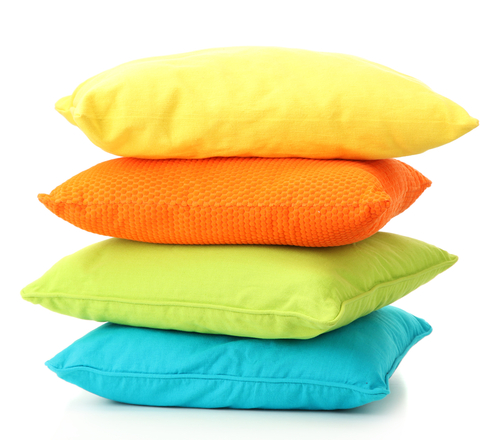
This week I’m going to blog about pillows which is right on time for me because I actually need new pillows and was putting off doing the research. I currently sleep without one because the pillows that I have are too thick and I tend to wake up with a stiff neck or head ache. Below are a sampling of pillow types along with pros and cons.
Memory Foam
Memory foam is polyurethane with added chemicals which increase the viscosity and density of the pillow. It molds to your neck and head within seconds because the materials react to body heat and pressure. Once the heat and pressure is removed, it returns back to its original shape.
Pros
- Provides comfort and support for people with neck, shoulder and back problems
Cons
- Memory is combustible (!)
- Emissions from memory foam may cause respiratory irritation (!)
- Traps body heat may sleep hot
- Some memory foam may emit a distinct chemical odor
Cervical Pillow
This pillow is well-contoured and shaped especially for back and side sleepers. The center is depressed and provides good support for the head. The material used is varied, from memory foam to buckwheat and water, so the pros and cons of each material is inherited.
Pros
- Cradles your neck and provides great support
- Helps you maintain proper posture when sleeping
Cons
- Not designed for stomach sleepers
Down/Feather pillow
Down and feather pillows are filled with the fluff from the bellies of waterfowl like duck and geese. In doing this research, I learned that the practice of obtaining this fluff is highly cruel to these animals and so my discussion of this type of pillow stops right here. Go here and here to see more about this horrible practice.
Down alternative…
Buckwheat
The hulls of buckwheat are used to make buckwheat pillows (the husks that protect the kernels).
Pros
- Inexpensive
- Natural (make sure you purchase from an organic manufacturer
- Long lasting
- Ideal for all sleepers because the hulls contour to the weight and shape of the body during sleep
- Provides natural air circulation between individual hulls which results in ideal temperatures for sleeping
Cons
- Weighs more than regular pillows
- May contain allergens for a small percentage of people who are allergic
- Makes noise when you turn your head
- Does not spring back into place like memory foam
Latex/Shredded Latex
I had never heard of this type of pillow before my research. They are made from latex rubber harvested from rubber trees grown on plantations in tropical countries.
There is a difference between latex, natural rubber, natural rubber latex and dry natural rubber. Read more about that here.
Pros
- Biodegradable
- Flame retardant
- Long lasting
- Resists mold and mildew
- 100% natural, organic material
- Insect resistant – wards off bed bugs and dust mites
- No harmful chemicals—yay!—and is non-toxic even if it’s burned
- Molds to your head and neck and provides a firm, cushioned sleeping surface
Cons
- But it looks like all the pros outweigh this one con in the long run
- Some people are allergic to latex
Polyester
Polyester is made from various man-made fillings and is the most popular type of pillow.
Pros
- Cheap
- Washable
Cons
- Poor ventilation
- Poor neck support
- Vulnerable to dust mites
Water
These pillows are partially filled with water. The top part is usually made out of polyester and the bottom part is cushioned by water.
Pros
- Cool temperature
- Heavier than regular pillows
- Adjustable water level which allows for flexible height and firmness
- Automatically contours to the head and neck
Cons
- Not comfortable for stomach sleepers
Microbeads
These pillows are filled with round polystyrene beads or “microbeads,” a smaller version of the material found in bean bags.
Pros
- Good air flow
- Conforms to head and neck
Cons
- Too firm for some people
- Chemical odor may be unbearable to some
- Tears during washing may clog plumbing
- Risk of inhaling beads in case pillow tears
Synthetic fiber
These fibers are made from synthesized polymers or small molecules. The compounds used to make these fibers come from raw materials like petrochemicals.
Pros
- Cheap
- Durable
- Waterproof
- Allergy free
- Easy to wash
- Flame resistant
Cons
- Highly static
- Non absorbent
- Doesn’t contour to head and neck
Cotton
These pillows are 100% pure, natural and absorbent.
Pros
- Allergy free
- Firmer and flatter than down pillows (which I will NEVER buy again)
Cons
- Flattens over time
- Feels hard once compressed
- Doesn’t contour well to head and neck
- Retains moisture which may encourage dust mites and mold if not cleaned regularly.
Wool
Pure, natural and breathable.
Pros
- Allergy free
- Stays cool during summer and warm during winter
- Airflow prevents moisture from sleep perspiration
- Natural insulation, keeps body at a constant temperature
Cons
- Flattens over time
- Feels hard once compressed
- Doesn’t contour to head and neck well
My Pillow
We have all heard of “My Pillow” on commercials and infomercials. I only know of one person who had one and his opinion was mixed regarding comfort.
It is filled with polyurethane foam which is shredded into different sized pieces and shapes much like a traditional buckwheat pillow. The pieces allow the pillow to be re-shaped to conform to the body.
Pros
- Washable
- Improves sleep for some
Cons
- Flattens over time
- Retains heat
- Costly
I definitely learned a lot in researching for this blog. Since I want be as organic as possible, (which includes avoiding anything that is cruel to animals), my choice is going to be between the buckwheat pillow and the latex pillow.
Links
https://hullopillow.com/what-are-the-benefits-of-a-buckwheat-pillow/
http://www.cbsnews.com/news/a-foul-truth-behind-the-down-in-pillows-and-comforters/
https://odyb.net/furniture/best-type-pillow-body-foam-memory-review-down-sleep/
http://www.consumersearch.com/as-seen-on-tv/my-pillow
https://hullopillow.com/my-pillow/
https://www.myorganicsleep.com/blogs/news/83947396-buckwheat-pillow-vs-shredded-latex

Keep this handy book by your desk while working or in your carry on when travelling for tips to keep you flexible and pain free.
